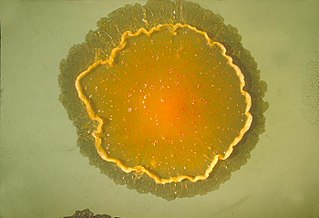
Mycobacterium marinum is a slow growing mycobacterium (SGM) belonging to the genus Mycobacterium and the phylum Actinobacteria. The strain marinum was first identified by Aronson in 1926 and it is observed as a pathogenic mycobacterium. For example, tuberculosis like infections in fish (mycobacteriosis) and skin lesions in humans.
Mycobacterium africanum is a species of Mycobacterium that is most commonly found in West African countries, where it is estimated to cause up to 40% of pulmonary tuberculosis. The symptoms of infection resemble those of M. tuberculosis.
Mycobacterium asiaticum is a slowly growing photochromogenic mycobacterium first isolated from monkeys in 1965. M. asiaticum can, but rarely, causes human pulmonary disease.
Mycobacterium boenickei is a member of the Mycobacterium fortuitum third biovariant complex. They are rapidly growing ubiquitous environmental organisms that normally inhabit soil, dust and water. These organisms frequently are human pathogens that cause a wide spectrum of clinically significant disease. It is important for practitioners to be aware of these organisms as possible etiological agents, as they are resistant to most first-line anti-tuberculous agents.
Mycobacterium botniense is a slowly growing Mycobacterium, which produces a yellow pigment. It was first isolated from a stream of water. M. botniense is most closely related to Mycobacterium xenopi. Etymology: botniense; of Botnia, referring to the Latin name of the province of Finland from which the isolation was made.
Mycobacterium canariasense is a rapidly growing, non-pigmented mycobacterium first isolated from blood samples obtained from 17 patients with febrile syndrome. Etymology: canariasense; referring to the Latin adjective of the Spanish islands where all strains were isolated.
Mycobacterium celatum is a species of the phylum Actinomycetota, belonging to the genus Mycobacterium.
Mycobacterium chlorophenolicum is a species of the phylum Actinomycetota, belonging to the genus Mycobacterium.
Mycobacterium conceptionense is a non pigmented rapidly growing mycobacterium was first isolated from wound liquid outflow, bone tissue biopsy, and excised skin tissue from a 31-year-old woman who suffered an accidental open right tibia fracture and prolonged stay in a river. Etymology: conceptionense, pertaining to Hôpital de la Conception, the hospital where the first strain was isolated.
Mycobacterium farcinogenes is a species of the phylum Actinomycetota, belonging to the genus Mycobacterium.
Mycolicibacter hiberniae is a species of bacteria in the phylum Actinomycetota.
Mycobacterium avium complex is a group of mycobacteria comprising Mycobacterium intracellulare and Mycobacterium avium that are commonly grouped because they infect humans together; this group, in turn, is part of the group of nontuberculous mycobacteria. These bacteria cause Mycobacterium avium-intracellulare infections or Mycobacterium avium complex infections in humans. These bacteria are common and are found in fresh and salt water, in household dust and in soil. MAC bacteria usually cause infection in those who are immunocompromised or those with severe lung disease.

Mycobacterium lentiflavum
Etymology: Lentus from Latin for slow, flavus, Latin for yellow.
Mycobacterium montefiorense is a species of bacteria which cause granulomatous skin disease of moray eels. Sequence analysis, of the 16S rRNA gene reveals M. montefiorense is most closely related to Mycobacterium triplex, an opportunistic pathogen of humans.
Mycobacterium vanbaalenii is a rapidly growing mycobacterium that can use polycyclic aromatic hydrocarbons. It was first isolated from petroleum-contaminated estuarine sediments and has been shown by 16S rRNA gene sequencing to be closely related to Mycobacterium aurum and Mycobacterium vaccae. M. vanbaalenii has potential use in the bioremediation of polycyclic aromatic hydrocarbon contaminated environmental sites. Etymology: vanbaalenii of Van Baalen, in memory of Dr Chase Van Baalen, late Professor at The University of Texas Marine Science Institute, Port Aransas Marine Laboratory, Port Aransas, TX, USA.
Mycobacterium sphagni is a species of Mycobacterium.
Mycobacterium porcinum is a species of Mycobacterium.
Mycobacterium novocastrense is a species of Mycobacterium.
Mycobacterium arosiense is a newly described species of Mycobacterium. It is a scotochromogen that derives its name from Arosia, the Latin name for the city of Aarhus (Denmark), where the strain was first isolated.

